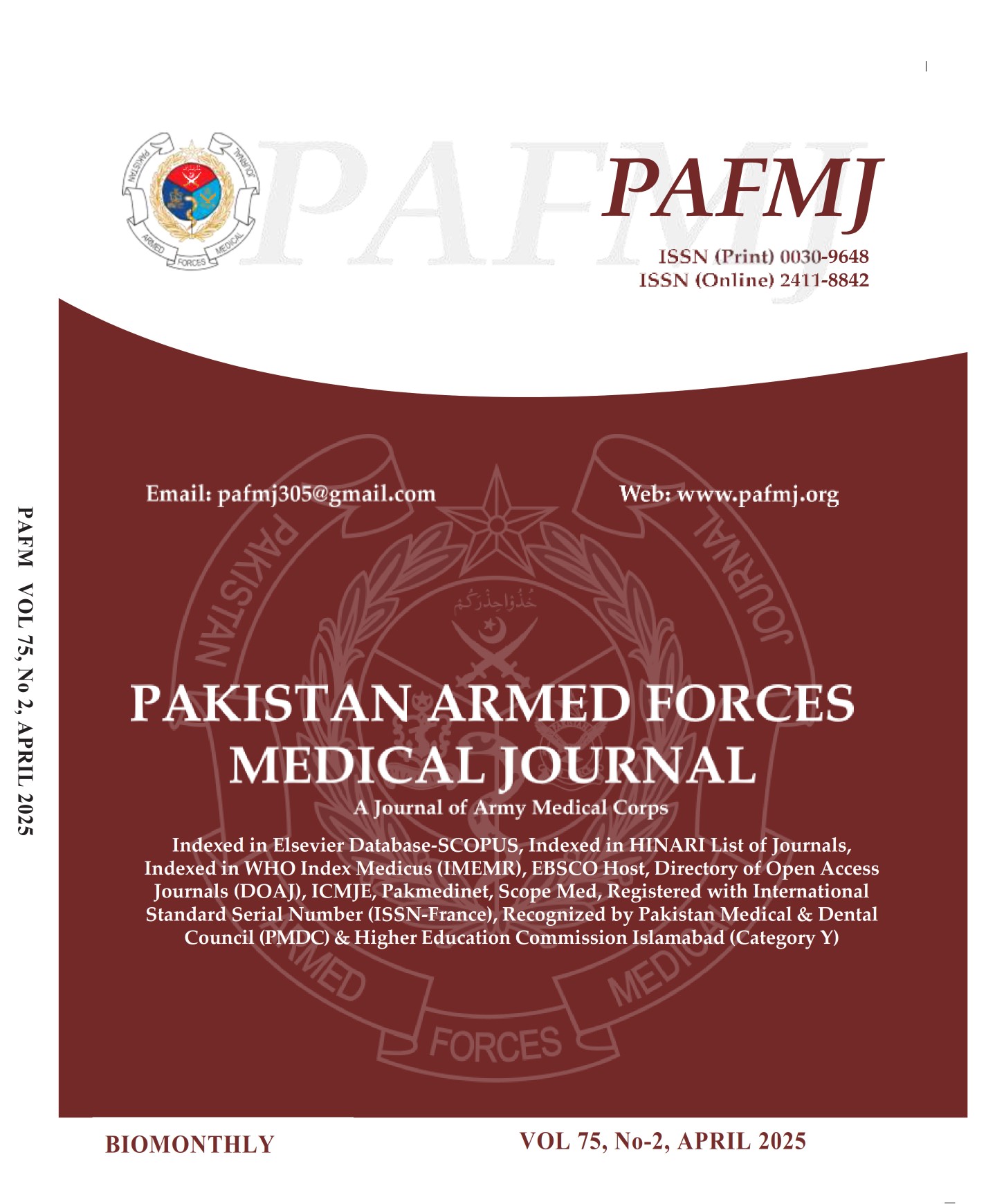Effect of Lung Recruitment in the Efficacy of Intubation-Surfactant-Extubation Treatment of Respiratory Distress Syndrome in Preterm Neonates
DOI:
https://doi.org/10.51253/pafmj.v75i2.10359Keywords:
Lung Recruitment, Mechanical Ventilation, Respiratory Distress Syndrome.Abstract
Objectives: To compare the efficacy of lung recruitment versus conventional care in preterm neonates with respiratory distress syndrome in terms of reduction in requirement for mechanical ventilation.
Study Design: Quasi-experimental study.
Place and Duration of Study: Department of Pediatrics, Combined Military Hospital, Rawalpindi Pakistan, Mar 2022 to Mar 2023.
Methodology: We conducted this study on 246 preterm neonates with respiratory distress syndrome. Neonates in the intervention arm received lung recruitment therapy with a pressure of 25 cmH2O for 15 seconds during surfactant administration. Both groups were subsequently placed on continuous positive pressure airway ventilation, failure of which was said to have occurred if the patient was unable to maintain SpO2 despite increasing FiO2 with worsening respiratory acidosis and apneic spells, which resulted in intubation and mechanical ventilation.
Results: A total of 246 premature neonates with a mean gestational age at birth of 31.88±2.42 weeks were studied. Requirements for mechanical ventilation were seen in 29.3% of those who received lung recruitment versus 43.1% of those without (p=0.024). The total number of complicated cases was significantly lower with lung recruitment: 8.9% versus 17.9% in those without recruitment (p=0.040); however, the frequency of individual complications like pneumothorax (p=0.213), intraventricular hemorrhage (p=0.281), necrotizing enterocolitis (p=0.327) and mortality (p=0.254) were not significantly different across the groups.
Conclusion: Using lung recruitment with administration of surfactant therapy for premature neonates is associated with reduced requirement for mechanical ventilation, duration of mechanical ventilation, and a reduction in total frequency of complications.
Downloads
References
Yadav S, Lee B, Kamity R. Neonatal Respiratory Distress Syndrome. In: StatPearls. Treasure Island (FL): StatPearls Publishing; 2022.
Chi M, Mei YB, Feng ZC. A review on neonatal acute respiratory distress syndrome. Zhongguo Dang Dai Er Ke Za Zhi 2018; 20(9): 724-728.
https://doi.org/10.7499/j.issn.1008-8830.2018.09.006
Ekhaguere OA, Okonkwo IR, Batra M, Hedstrom AB. Respiratory distress syndrome management in resource limited settings-Current evidence and opportunities in 2022. Front Pediatr 2022; 10(1): 961509.
https://doi.org/10.3389/fped.2022.961509
Jena SR, Bains HS, Pandita A, Verma A, Gupta V, Kallem VR, et al, On Behalf Of Sure Group. Surfactant therapy in premature babies: SurE or InSurE. Pediatr Pulmonol 2019; 54(11): 1747-1752.
https://doi.org/10.1002/ppul.24479
Goss KC, Gale C, Malone R, Longford N, Ratcliffe K, Modi N. Effect of surfactant dose on outcomes in preterm infants with respiratory distress syndrome: the OPTI-SURF study protocol. BMJ Open 2020; 10(12): e038959.
https://doi.org/10.1136/bmjopen-2020-038959
Kamga-Gninzeko FJ, Valentine MS, Tho CK, Chindal SR, Boc S, Dhapare S, et al. Excipient Enhanced Growth Aerosol Surfactant Replacement Therapy in an In Vivo Rat Lung Injury Model. J Aerosol Med Pulm Drug Deliv 2020; 33(6): 314-322.
https://doi.org/10.1089/jamp.2020.1593
Herman L, De Smedt SC, Raemdonck K. Pulmonary surfactant as a versatile biomaterial to fight COVID-19. J Control Release 2022; 342(1): 170-188.
https://doi.org/10.1016/j.jconrel.2021.11.023
Konduri GG, Lakshminrusimha S. Surf early to higher tides: surfactant therapy to optimize tidal volume, lung recruitment, and iNO response. J Perinatol 2021; 41(1): 1-3.
https://doi.org/10.1038/s41372-020-0764-4
Ekhaguere OA, Okonkwo IR, Batra M, Hedstrom AB. Respiratory distress syndrome management in resource limited settings-Current evidence and opportunities in 2022. Front Pediatr 2022; 10(1): 961509.
https://doi.org/10.3389/fped.2022.961509
Peel JK, Funk DJ, Slinger P, Srinathan S, Kidane B. Positive end-expiratory pressure and recruitment maneuvers during one-lung ventilation: A systematic review and meta-analysis. J Thorac Cardiovasc Surg 2020; 160(4): 1112-1122.e3.
https://doi.org/10.1016/j.jtcvs.2020.02.077
Yang Y, Yan W, Ruan M, Zhang L, Su J, Deng H, et al. Lung recruitment improves the efficacy of intubation-surfactant-extubation treatment for respiratory distress syndrome in preterm neonates, a randomized controlled trial. BMC Pediatr 2022; 22(1): 14.
https://doi.org/10.1186/s12887-021-03096-y
Mohapatra V, Saraogi S, Misra S. Demographic Profile, Etiology, and Perinatal Outcome Associated With Preterm Birth in a Tertiary Hospital of Eastern India: A Retrospective Study. Cureus 2022; 14(6): e26066.
https://doi.org/10.7759/cureus.26066
Kim JK, Hwang JH, Lee MH, Chang YS, Park WS. Mortality rate-dependent variations in antenatal corticosteroid-associated outcomes in very low birth weight infants with 23-34 weeks of gestation: A nationwide cohort study. PLoS One 2020; 15(10): e0240168.
https://doi.org/10.1371/journal.pone.0240168
Kim JH, Lee SM, Lee YH. Risk factors for respiratory distress syndrome in full-term neonates. Yeungnam Univ J Med 2018; 35(2): 187-191.
https://doi.org/10.12701/yujm.2018.35.2.187
Condò V, Cipriani S, Colnaghi M, Bellù R, Zanini R, Bulfoni C, et al. Neonatal respiratory distress syndrome: are risk factors the same in preterm and term infants? J Matern Fetal Neonatal Med 2017; 30(11): 1267-1272.
https://doi.org/10.1080/14767058.2016.1210597
Vento G, Ventura ML, Pastorino R, van Kaam AH, Carnielli V, Cools F, et al. Lung recruitment before surfactant administration in extremely preterm neonates with respiratory distress syndrome (IN-REC-SUR-E): a randomised, unblinded, controlled trial. Lancet Respir Med 2021; 9(2): 159-166.
https://doi.org/10.1016/S2213-2600(20)30179-X
Lista G, Fontana P, Castoldi F, Cavigioli F, Dani C. Does sustained lung inflation at birth improve outcome of preterm infants at risk for respiratory distress syndrome? Neonatology 2011; 99(1): 45-50.
https://doi.org/10.1159/000298312
Jiravisitkul P, Rattanasiri S, Nuntnarumit P. Randomised controlled trial of sustained lung inflation for resuscitation of preterm infants in the delivery room. Resuscitation 2017; 111(1): 68-73.
Downloads
Published
Issue
Section
License
Copyright (c) 2025 Waseem Ahmed, Abdullah Akram, Farooq Ikram, Sadia Naz, Mahammad Tariq Nadeem, Babar Ali

This work is licensed under a Creative Commons Attribution-NonCommercial 4.0 International License.















